Little Red Book maintains a stable position in the buyers’ journey of 18 to 35-year-old Chinese females. The brands that know exactly how to conduct SEO in Little Red Book KOL marketing campaigns have a distinct advantage influencing the buyers’ journey of this highly-valuable demographic. This Little Red Book (Xiaohongshu) SEO manual for KOL marketing provides a comprehensive implementation strategy, which should be used in all KOL marketing campaigns.
Why SEO on Little Red Book (Xiaohongshu) is Important
According to McKinsey’s China Digital Consumer Trends 2019 report, social media has an increasingly significant impact on the entire Chinese buyer’s journey. The most astonishing behavior shift is direct purchases made through a social channel, which increased 3.6 times from 2017 to 2019.
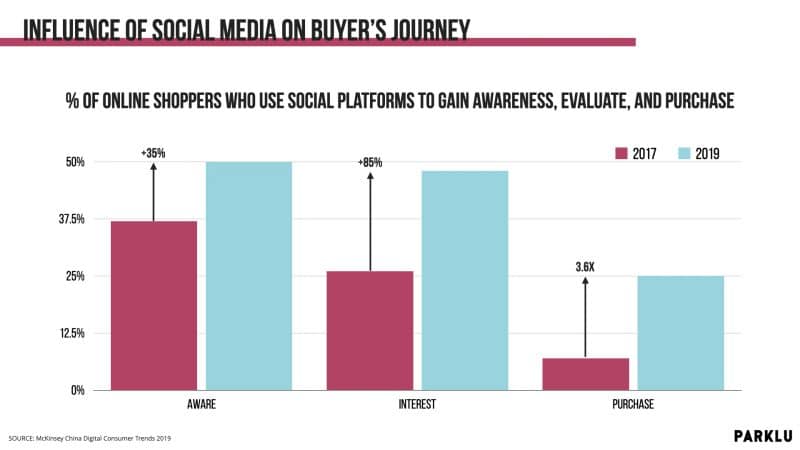
Last year, PARKLU collaborated with Kung Fu Data to uncover correlations between KOL posts that mentioned the skincare and cosmetics brand Kiel’s on Little Red Book, Weibo, and WeChat and shopper’s searches for Kiel’s made on Taobao and Tmall. Incredibly, we found a 90% correlation between Kiel’s KOL marketing posts on Little Red Book and Kiel’s Taobao/Tmall search volumes, which far outpaced Weibo with a 60% correlation and WeChat at a 55% correlation.
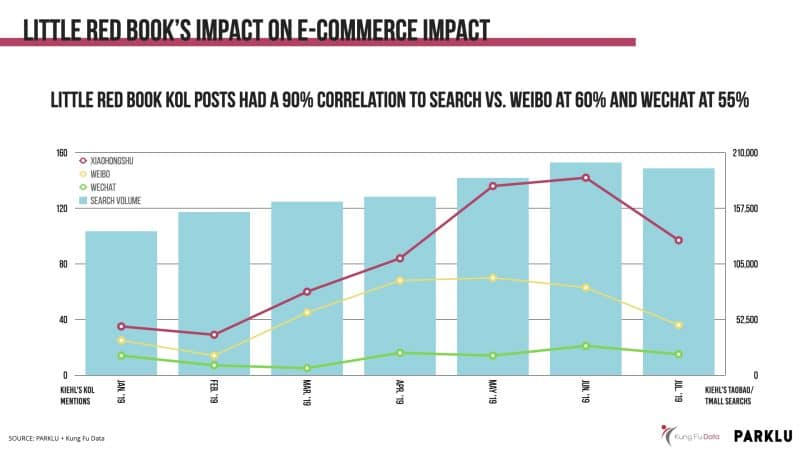
If the above is not enough to make a case for the importance of SEO on Little Red Book, we have one more reason to implement a robust SEO strategy in all Xiaohongshu KOL marketing campaigns. Baidu indexes Little Red Book webpages. The Little Red Book app is not the only place users can access RED posts; in fact, posts can be accessed from a mobile or desktop web browser. Baidu’s search engine ranks and displays Little Red Book posts in search results. And Little Red Book is a Baidu ranking powerhouse with a domain score of 79, more than 279 thousand ranking keywords, 13.8 million backlinks, and monthly traffic over 2 million (this is web browser traffic). If a post uses a proper SEO strategy, it may highly rank in Baidu search results.
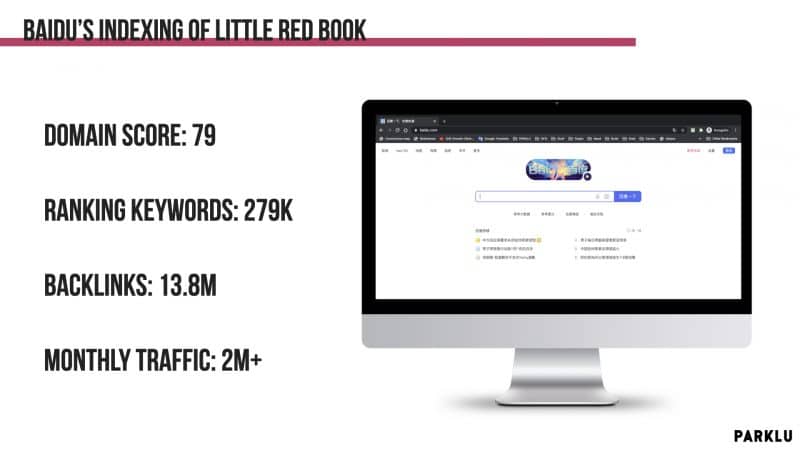
Understanding Little Red Book (Xiaohongshu) User Behavior
Before we dive into Little Red Book (Xiaohongshu) SEO, it’s prudent first to analyze the motivations and thought processes of the typical user. Content that is in line with user expectations will ultimately increase the chance of SEO success as we will discover later, high ranking posts are dependent on user engagement.
When users open the Little Red Book app, they are doing so with the intent to learn in order to make a more rational decision. The intention to learn how to judge a situation taps into the higher functions of the user’s cerebral cortex (human brain). Therefore, it is vital to design content that appeals to the prefrontal cortex, which is very different from creating content on Douyin, where videos play to the pleasure-seeking triune brain (mammalian brain).

We can not overstate the importance of understanding a platform’s value framework as it relates to its users’ expectations. Aligning a post’s value proposition with user expectations should become one of the guiding principles of any content published on a given platform. Little Red Book is unique in that it falls squarely in the high-utility and high-entertainment vector. Content must strike a balance between its ability to provide users with pleasure and being useful. Undoubtedly, this can be challenging, but that’s what Little Red Book KOLs are for, they have master the art of this balance.
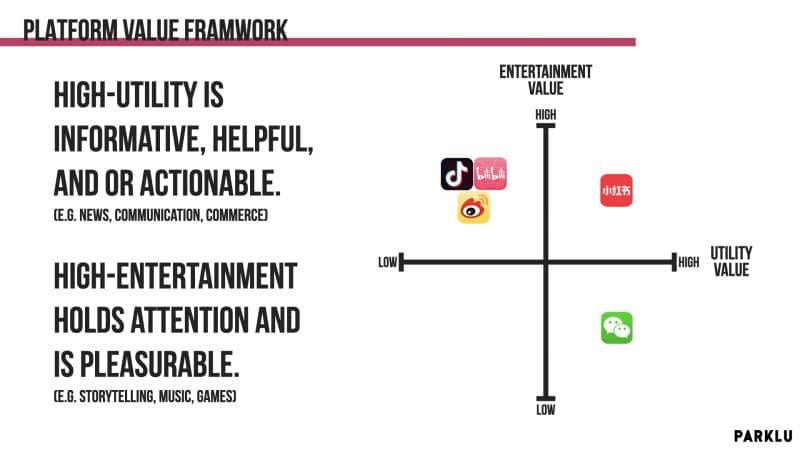
Little Red Book is just one stop, albeit a critical stop, on a multi-step journey for the typical 18 to 35-year-old Chinese female. Red provides shoppers with a crucial point of validation as the authentic nature of the content is the feedback many need to make a more pragmatic decision. It’s important to note that the comments section below a post can play as important a role as the original post itself. User comments provide another layer of authenticity, and this is precisely why RED’s SEO algorithm also places so much weight on this metric.
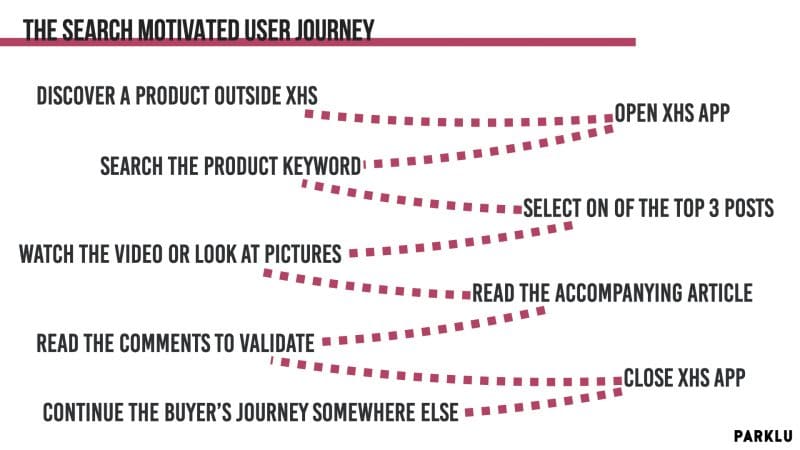
How SEO on Little Red Book (Xiaohongshu) Works
Now we will start to carve up the meat of the subject. Having a basic understanding of SEO can be helpful, but it’s not necessary. We’ll try to break the topic down to make it as easy to implement as possible.
In website-based SEO, on-page SEO refers to the content and HTML source code of a page that can be optimized. In the case of RED SEO, on-page SEO refers to the type and structuring of the content. For any given post, it’s prudent to select one to three keywords or a keyword phrase. That keyword then needs to be used in the title of the post, the first paragraph, and half of one percent throughout the post (for every 200 characters, use the keyword at least once). The other very important factor to take into consideration to rank well is to recognize RED’s preferential treatment of videos. The top-ranking of most keywords is now dominated by video posts, so to be SEO competitive, any given KOL marketing campaign must focus on video content. Adding a long-form article to the video is still a best practice, as this will provide Little Red Book’s SEO spiders the context they need.
Another super critical factor to the successful ranking of any given post is the size of the account publishing the post. It seems that KOL’s post do get some degree of preferential treatment by RED’s SEO algorithm, but we must also remember that an account with a large number of followers is much more likely to receive a large number of engagements, which is going to give a KOL’s post a significant ranking edge. Therefore, to have any chance at all of highly-ranking for more competitive keywords, a KOL account will likely need to be engaged.
Traditional off-page SEO refers to backlinks and other external signals like social media. In the case of RED, off-page SEO refers to user engagement with a given post. There are five forms of engagement any post can receive on RED, and not all of them are equally weighted (the importance they are presented as an SEO ranking factor). Sharing is not a visible metric to users on RED; however, it’s always considered to most important factor on any given social network. Next is collect, which can somewhat act as a proxy for the traditional share feature found on most social platforms. Then comments, likes, and views.
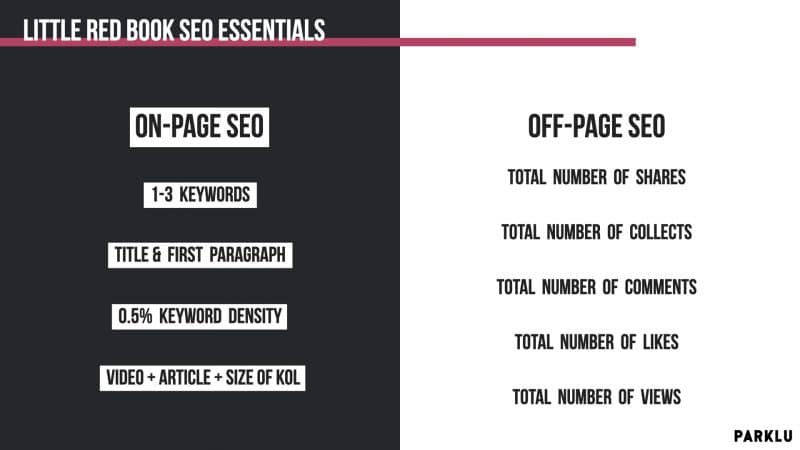
It’s not 100% clear, but large accounts’ engagements likely play a factor in ranking. So, we recommend having the KOLs in any given KOL marketing campaign share (note, it’s only necessary to hit the share button, the content doesn’t need to be shared), favorite, comment, and like other KOLs content in a given campaign.
One other thing to note is the importance of the first 24 hours of a post. The first 24 hours of any given post are essential to the organic visibility in users’ feeds. The more engagement in the first 24 hours is a trigger that tells RED that a post is worth spreading and increases baseline visibility. Motivating KOLs’ core followers to engage with a fresh post is vital to the longer-term success of a posts likelihood to rank well.
How to Select Little Red Book (Xiaohongshu) Keywords
When we distill Little Red Book down to its fundamental user value propositions, we find that it is essentially a product review platform and search engine. Posts on Little Red Book are similar to traditional website pages, and the search function is like web search engines. Just like classic websites and search engines, keywords are, well, key. And just like most things in life, planning is the essential part. All will be for not if the right keywords are not selected. Don’t waste a perfectly good KOL marketing campaign with impossible to rank for keywords or ones users never search for.
The best place to start discovering Little Red Book keywords is by using RED’s search engine. Start typing a potential keyword into RED’s search bar, and the number of posts ranking for that keyword will be displayed, along with the number of brands mentions in those ranking posts. The goal is to uncover less competitive yet important keywords that will lead users to relevant content associated with your brand.
Focusing on long-tail keyword phrases has two main advantages. Firstly, keyword phrases are typically less competitive and, therefore, easier to rank for. Secondly, long-tail keywords will lead to greater context matching between a user’s search and a post’s content. This matching of search and answer also increasing the potential of conversion as the users will be able to find the exact solution they are looking for mitigating the need to look further.
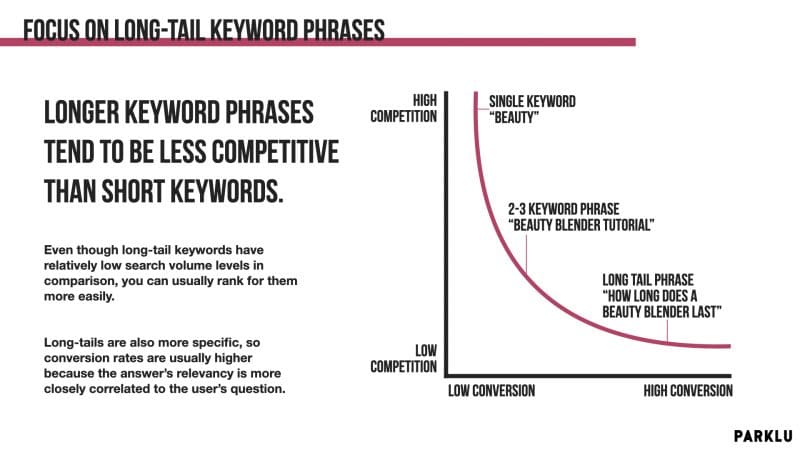
At this stage, results will need to be manually entered into an excel spreadsheet, as later we will need to compare all keywords against each other. The primary data points that will need collecting are the keywords, number of posts, number of products, and the statistics on the first four (or first three posts if there is an ad in one of the first four spots) ranking posts. In the case below, we took the root keyword “beauty blender” and attempted to find keyword phrases we believed were worth pursuing.

After selecting a keyword, the first four posts are what we call “above the fold” ranking posts, meaning that they are the first visible posts without scrolling down. With traditional web search engines, above the fold rankings, on average, capture more than 60% of the click-through traffic, with the top getting 42% of clicks; the second gets 11%, and the third only gets 8%.
The next step is to collect the ranking factor metrics for the above the fold posts. We will first collect the number of collects, comments, and likes. Bellow, we added these metrics together to create a single engagement total. We want to know the size of the KOLs that have created the posts. We generalize KOL size with Top, Mid, Micro, and Long-tail. To understand RED KOL tier follower sizes, use PARKLU’s KOL Budget Calculator. Then we note the content type and whether the title, first paragraph, and content use the exact keyword or a variation. If the KOL used a variation of the keyword, an exact usage of the keyword should have a better chance of ranking.
It is important to note that post rankings change from day to day, the ranking changes are not extremely dramatic, but posts do shift up and down several positions. However, the ranking factors between shifting posts are generally similar, though we see cases where low engaged posts have high ranks from time to time. RED’s SEO algorithm is continuously learning in an attempt to provide users with the most relevant content. Do not get distracted by these daily changes; the best we can do is get a generalized sense of what it takes to rank above the fold for any given keyword.

Hashtags are worth mentioning, but not the focus of this Little Red Book SEO strategy guide as hashtags are not displayed in search results. One hashtag can be added to each post, and just like keywords, the primary metrics (posts and views) are easy to discover, record, and evaluate for the purposes of ranking. The advantage of hashtags is that users can follow them. So, newly-ranking posts for popular hashtags can receive significant attention because they can appear in users’ main page feed.
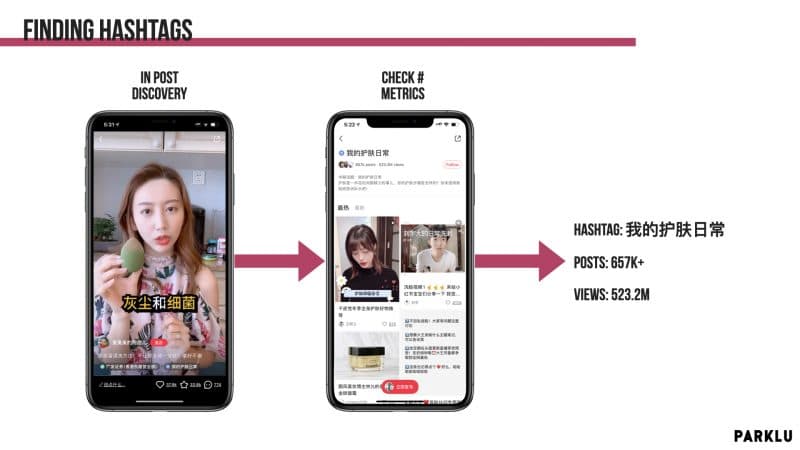
The last step is not necessary but can be interesting as it can provide some estimates of keyword popularity and upward or downward trends in search. We can take our keyword list and enter it into Baidu’s Search Index tool to see daily search volume and period over period trends. These results are just a proxy, but interesting and potentially useful nonetheless. Another interesting thing to note is the prevalence of Baidu search users adding “Little Red Book” (小红书) to the beginning of searches. Little Red Book is indeed a trusted source of information on the internet, further reinforcing the importance of optimizing posts for search.
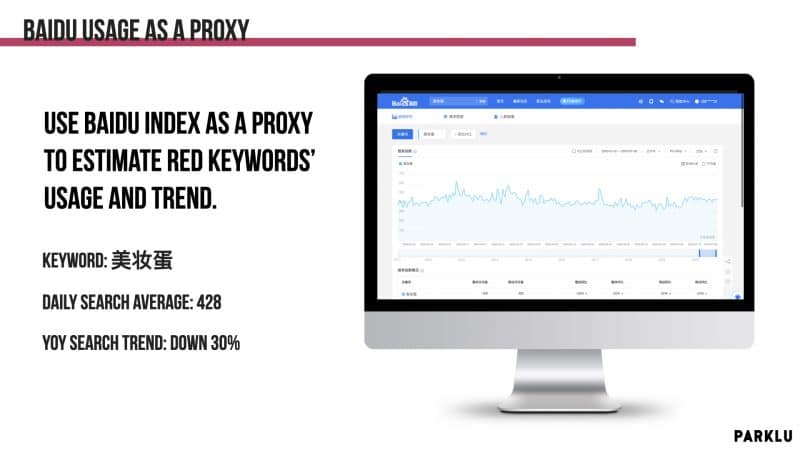
Use Little Red Book (Xiaohongshu) Keywords in KOL Marketing
By this point, we should have selected the most relevant keywords we want to rank for. The next task is to aline and assign these keywords to KOLs. Remember, it’s better to rank above the fold for a less competitive, more specific long-tail keyword phrase than to rank below the fold for a more competitive general keyword. The main goal here is to provide the KOLs that will participate in your coming campaign with keywords that currently have smaller KOLs ranking above the fold. We want to aim for that top spot so we can catch 42%+ of the click-throughs, so we will use the KOL with the largest following as the target metric to beat with the KOLs we have to select from our campaign. If we are not collaborating with any KOLs larger than the largest KOL ranking above the fold, we will not use that keyword in the campaign.
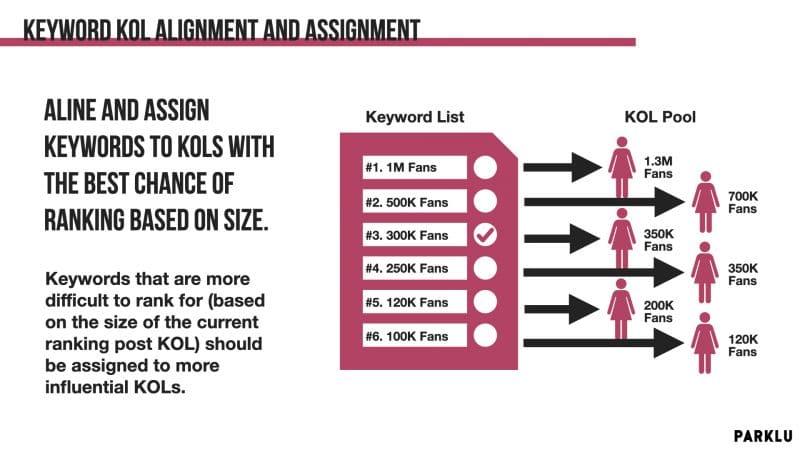
This single most important subjective factor to ranking will be the quality of the content. All the prep work we have done will be for not if the content the KOL produces is not better than the content that is currently ranking above the fold. KOLs should use the content that currently ranks for the keyword they have been as a guide to create something better. Making something better is a classic SEO strategy. Typically making better content means making something more comprehensive so that it is more helpful, and as we have already learned, RED users are trying to make the most educated decisions possible, so the content that KOLs create needs to be more helpful than the content that already exists.

The next trick will be stimulating engagement, which will be the most objective factor used by Little Red Book to determine to rank. This is where we need to pull out all the stops. Unfortunately, at the time of writing this article, RED is only piloting a KOL marketing paid boosting service, similar to Weibo fensitoutiao (粉丝头条). However, once this post boosting feature is fully rolled out, it will be an essential part of all KOL marketing campaigns that have a goal of ranking for selected keywords. Until then, get creative! Firstly, KOLs should add a comment to the post offering a luck draw gift to anyone who engages with the post. KOLs should also be instructed to share the post with their private communities and offer rewards for proof of engagement.
The last tactic we’ll mention is location-based discovery, which is a form of contextual search. There is simply no reason for the KOLs in a KOL marketing campaign not to add a location tag to their posts. The “Nearby” tab at the top of RED’s app can be an essential way for users to find what they are looking for, especially if it’s a location-sensitive post, like travel-related or a restaurant.

To wrap this up, we want to encourage you. This step-by-step Little Red Book (Xiaohongshu) SEO manual for KOL marketing might have been a little daunting to read, and the implementation of these tactics definitely will be. But nothing good comes easy. 加油!





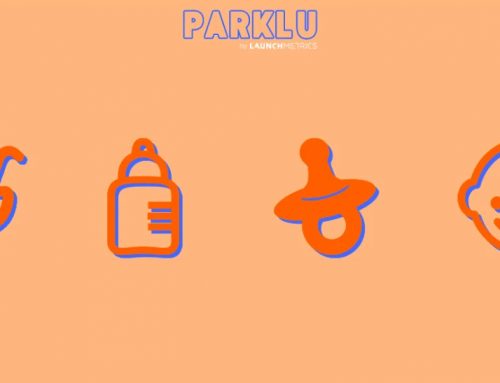

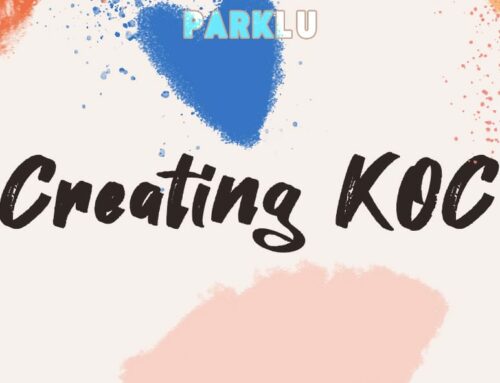
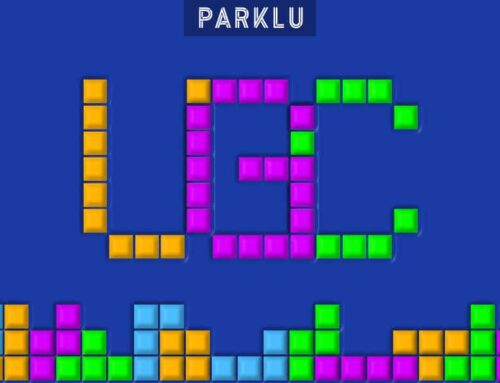

Leave A Comment